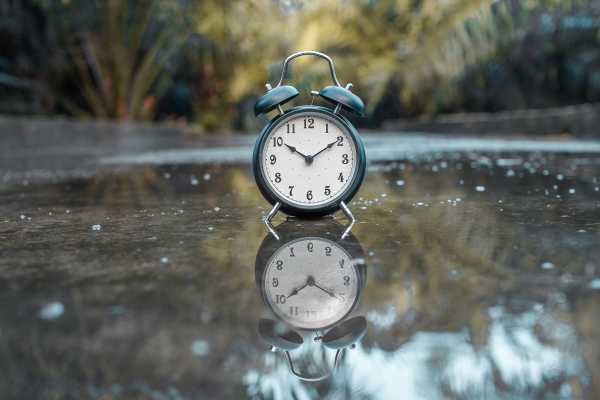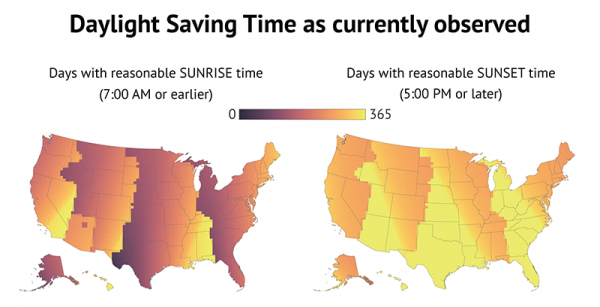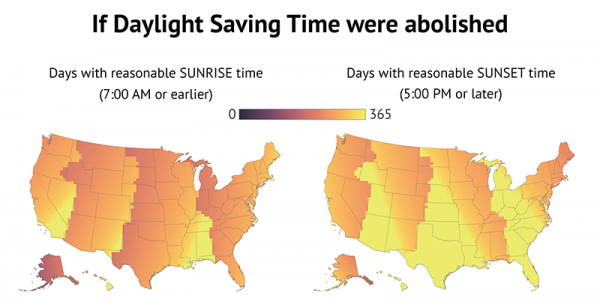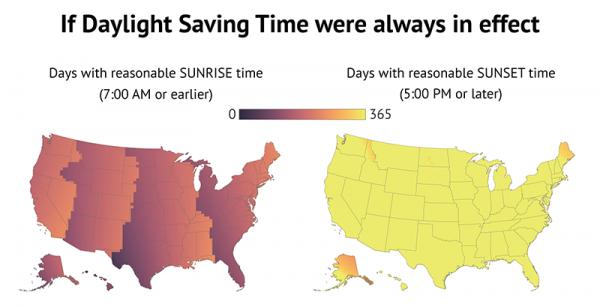
On Sunday, November 1, at 2 am, daylight saving time ends. We’ll set our clocks back one hour, heralding the end of daylight saving time for much of the country.
The biggest consequence: The change shifts daylight back into the morning hours. That means sunrise will happen one hour earlier on November 1 (sadly, it means sunset will occur one hour earlier as well.) For weekend workers, at least, it means an additional glorious hour of sleep on Sunday. Hurrah!
Yet as simple as it seems, there is still a lot of confusion about daylight saving time. The first thing to know: Yes, it ends in the fall, just as the decrease in daylight hours is becoming noticeable.
Let’s sort it all out.
1) Why do we need to “save” daylight hours in the summer?
Daylight saving time in the US started as an energy conservation trick during World War I and became a national standard in the 1960s.
The idea is that in the summer months, we shift the number of daylight hours we get into the evening. So if the sun sets at 8 pm instead of 7, we’d presumably spend less time with the lights on in our homes at night, saving electricity.
It also means that you’re less likely to sleep through daylight hours in the morning (since those are shifted an hour later too). Hence “saving” daylight hours for the most productive time of the day.
Overall: We agree, the name is kind of confusing.
2) Isn’t it “daylight savings time” not “daylight saving time”?
No, it’s definitely called “daylight saving time.” Not plural. Be sure to point out this common mistake to friends and acquaintances. You’ll be really popular.
3) Does it actually lead to energy savings?
As Joseph Stromberg outlined in an excellent 2015 Vox article, the actual electricity conservation from the time change is unclear or nonexistent:
4) Why doesn’t Arizona or Hawaii change its clocks?
Arizona has a simple way to deal with daylight saving time: Most of the state ignores it.
Fifty years ago, the state legislature opted to keep the clocks in most of the state in standard time all year. One reason: Arizona summers are very hot, and an earlier sunset gives residents more time to enjoy tolerable temperatures before bed, as AZcentral explains. Confusing matters: The Navajo Nation within Arizona does use DST.
Hawaii also doesn’t observe DST. The island state is the farthest south of all states and rejected it because it doesn’t see a hugely noticeable daylight hour difference between winter and summer months.
5) Didn’t a bunch of states pass laws making daylight saving time permanent? What happened with those?
If you’re a bit confused about which states follow daylight saving time and which do not, I don’t blame you. That’s because lately, a few states have looked into joining Arizona and Hawaii, but with a twist: They want daylight saving time to be in place all year long.
In the November 2018 election, Californians voted in favor of a ballot measure that paves the way for this. The measure, which passed with 60 percent of the vote, simply grants the California Legislature the power to vote to change the clocks permanently. Any changes would need to start with a two-thirds majority vote in the state legislature — which hasn’t happened yet.
And even then, the time change wouldn’t be a given. The federal government would have to approve it; that has uncertain prospects too.
In 2018, the Florida government approved the delightfully named Sunshine Protection Act, which seeks to permanently leave Florida in daylight saving time. (Essentially, it would mean that Florida will be one hour ahead of the rest of the East Coast during the winter months.) Massachusetts has looked into a similar measure, too.
The bill is still waiting on approval from Congress before it can go into effect. Florida Sen. Marco Rubio has put forth a few bills to push forward the approval, but they haven’t moved at all. Arkansas, too, passed a bill to make daylight saving time permanent, but it included the condition that the changes wouldn’t go into effect until its bordering states changed their clocks permanently too. Other states that have approved legislation to enact year-long daylight saving time include Washington, Tennessee, Oregon, Nevada, and Alabama. Some Maryland legislators are interested, too. But none of the changes can go into effect without approval from the federal government.
So for now, all these states will be changing their clocks on Sunday along with the rest of us. Sorry!
(It appears other countries are also interested in getting rid of DST, or keeping it in place forever: Some members of the European Parliament, the governing body of the European Union, want to abolish clock changes there too.)
6) What would happen if daylight saving time were abolished? Or if it were extended forever?
It’s worth thinking about what would happen if Congress abolished daylight saving time (or kept it going all year long).
How might our patterns change? Blogger and cartographer Andy Woodruff decided to visualize this with a great series of maps.
The goal of these maps is to show how abolishing daylight saving time, extending it all year, or going with the status quo changes the number of days we have “reasonable” sunrise and sunset times.
Reasonable, as defined by Woodruff, is the sun rising at 7 am or earlier or setting after 5 pm (so one could, conceivably, spend some time in the sun before or after work).
This is what the map looks like under the status quo of twice-yearly clock shifts. A lot of people have unreasonable sunrise times (the dark spots) for much of the year:

Here’s how things would change if daylight saving were abolished (that is, if we just stuck to the time set in the winter all year). It’s better, particularly on the sunrise end:

And here’s what would happen if daylight saving were always in effect. The sunrise situation would actually be worse for most people. But many more people would enjoy after-work light — and there’s a strong argument to make that this after-work light is actually worth more. (More on that below.)

(Note: The length of light we experience each day wouldn’t actually change; that’s determined by the tilt of Earth’s axis. But we would experience it in times more accommodating for our modern world. Be sure to check out the interactive version of these maps on Woodruff’s website.)
In 2015, Stromberg made the compelling case that the daylight saving time shift into the evening should be extended year-round. Having more light later could benefit us in a surprising number of ways:
- People engage in more leisure activities after work than beforehand, so we’d likely do more physical activity over sedentary leisure activities. Relatedly, studies show that kids get more exercise when the sun is out later in the evening.
- Stromberg also cites some evidence that robberies decrease when there’s more sun in the evening hours.
- There could be economic gains, since people “take short trips, and buy things after work — but not before — so a longer DST slightly increases sales,” he writes.
7) Is daylight saving time dangerous?
A bit. When we shift clocks forward one hour in the spring, many of us will lose that hour of sleep. In the days after daylight saving time starts, our biological clocks are a little bit off. It’s like the whole country has been given one hour of jet lag.
In September, the American Academy of Sleep medicine called for the end of daylight saving time clock changes.
“An abundance of accumulated evidence indicates that the acute transition from standard time to daylight saving time incurs significant public health and safety risks, including increased risk of adverse cardiovascular events, mood disorders, and motor vehicle crashes,” the academy wrote in a statement.
One hour of lost sleep sounds like a small change, but we humans are fragile, sensitive animals. Small disruptions in our sleep have been shown to alter basic indicators of our health and dull our mental edge.
And when our biological clocks are off, everything about us is out of sync. Our bodies run this tight schedule to try to keep up with our actions. Since we usually eat a meal after waking up, we produce the most insulin in the morning. We’re primed to metabolize breakfast before even taking a bite. It’s more efficient that way.
(There’s some good research that finds taking over-the-counter melatonin can help reset our body clocks to a new time. Read more about that here.)
Being an hour off schedule means our bodies are not prepared for our actions at any time of the day.
One example: driving.
In 1999, researchers at Johns Hopkins and Stanford universities wanted to find out what happens on the road when millions of drivers have their sleep disrupted.
Analyzing 21 years of fatal car crash data from the US National Highway Transportation Safety Administration, they found a very small, but significant, increase in road deaths on the Monday after the clock shift in the spring: The number of deadly accidents jumped to an average of 83.5 on the “spring forward” Monday compared with an average of 78.2 on a typical Monday.
And it seems it’s not just car accidents. Evidence has also mounted of an increase in incidences of workplace injuries and heart attacks in the days after we spring forward.
8) How can we abolish daylight saving time, or extend it year-round?
That’s easy! Well, not really: All it would take is an act of Congress. But I wouldn’t count on this happening anytime soon.
Help keep Vox free for all
Millions turn to Vox each month to understand what’s happening in the news, from the coronavirus crisis to a racial reckoning to what is, quite possibly, the most consequential presidential election of our lifetimes. Our mission has never been more vital than it is in this moment: to empower you through understanding. But our distinctive brand of explanatory journalism takes resources. Even when the economy and the news advertising market recovers, your support will be a critical part of sustaining our resource-intensive work. If you have already contributed, thank you. If you haven’t, please consider helping everyone make sense of an increasingly chaotic world: Contribute today from as little as $3.
Sourse: vox.com





